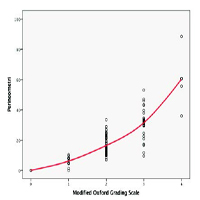Correlation of levator ani muscle strength measurement between Modified Oxford Grading Scale and perineometer on pelvic organ prolapse patient

All claims expressed in this article are solely those of the authors and do not necessarily represent those of their affiliated organizations, or those of the publisher, the editors and the reviewers. Any product that may be evaluated in this article or claim that may be made by its manufacturer is not guaranteed or endorsed by the publisher.
Authors
Pelvic Organ Prolapse (POP) is a debilitating condition affecting about half of all women aged of more than 60 years globally. Reduced levator ani muscle strength in POP is associated with worse symptoms and prognosis. Measurement of levator ani muscle strength can be done with several tools such as perineometer and digital palpation. However, there is currently no study regarding conformity between tests. The aim of this study is to determine the correlation between tests in POP patients. An analytic observational study using cross sectional design was done to determine conformity between perineometer and digital examination using Modified Oxford Grading Scale (MOS) in Dr Cipto Mangunkusumo National General Hospital, Indonesia during the period of July, 2018 to June, 2020. Correlation between tests was determined using Spearman test. Cut-off of perineometer reading for each MOS score was also determined. A total of 110 subjects examined with both perineometer and digital palpation were recruited to the study. Positive correlation was observed between perineometer reading and Modified Oxford Grading Scale (r = 0.790, p < 0.001). According to the result, values between 0.01 – 9.64 cmH2O correspond to very weak pressure (MOS 1); 9.65 – 22.49 cmH2O represent weak pressure (MOS 2); 22.5 – 35.24 cmH2O represent moderate pressure (MOS 3); ≥ 35.25 cmH2O represent good pressure (MOS 4). There was a strong correlation between MOS and perineometer result for measuring levator ani strength in POP patients.
How to Cite
PAGEPress has chosen to apply the Creative Commons Attribution NonCommercial 4.0 International License (CC BY-NC 4.0) to all manuscripts to be published.






